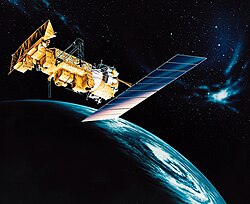 The TIROS-1 prototype on display at the Smithsonian National Air and Space Museum. | |
| Mission type | Weather satellite |
|---|---|
| Operator | NASA [1] |
| Harvard designation | 1960 β 2 |
| COSPAR ID | 1960-002B |
| SATCAT no. | 29 |
| Mission duration | 75 days (90 days planned) |
| Spacecraft properties | |
| Spacecraft type | TIROS |
| Manufacturer | RCA Astro |
| Launch mass | 122.5 kilograms (270 lb) |
| Start of mission | |
| Launch date | 1 April 1960, 11:40:09 GMT |
| Rocket | Thor DM 18-Able II |
| Launch site | Cape Canaveral, LC-17A |
| End of mission | |
| Last contact | 15 June 1960 |
| Orbital parameters | |
| Reference system | Geocentric |
| Regime | LEO |
| Eccentricity | 0.00401 |
| Perigee altitude | 693 kilometres (431 mi) |
| Apogee altitude | 750 kilometres (470 mi) |
| Inclination | 48.40° |
| Period | 99.16 minutes [2] |
| Epoch | 1 Apr 1960 11:45:00 |
| Instruments | |
| Two slow-scan visible television cameras (wide and narrow-angle); horizon and sun angle sensors | |
TIROS-1 (or TIROS-A) was the first operational weather satellite, [a] the first of a series of Television Infrared Observation Satellites (TIROS) placed in low Earth orbit.








